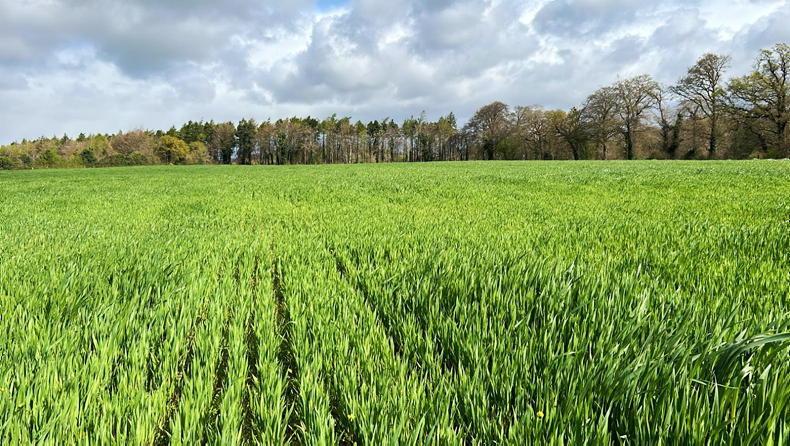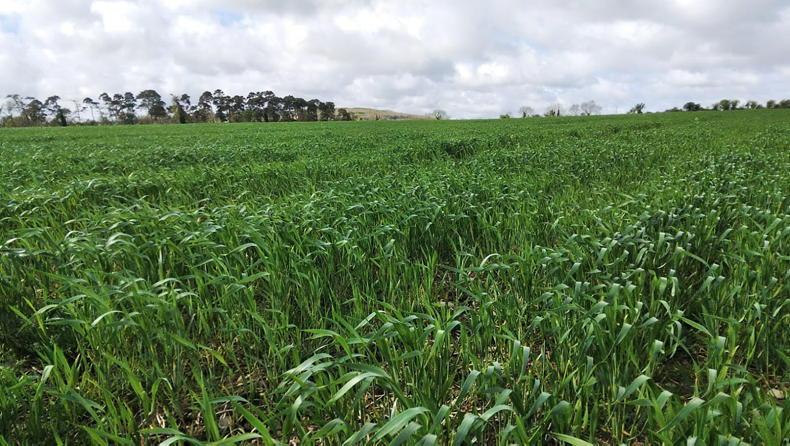The weather has finally turned in Wexford, allowing Barty to get out on the land in the past few days. This is a welcome respite after 150mm of rain from the start of March up to last week.
The Craft winter malting barley received the last of its nitrogen fertiliser at the weekend, bringing it up to a total of 169kg N/ha.
The crop also received its T1 spray at the weekend, consisting of Axial Pro, Helix, Silvron Xpro, Mirror and Seabio, which is a seaweed extract. Barty then came back this week with Medax Max. The crop is currently at GS33, and is coming along nicely. It had lost some of its colour but the nitrogen application should keep it green.
Barty spent Saturday and Sunday getting ready to sow Planet spring malting barley. He had already ploughed all of his land in early February.
He would usually plant the barley in March, as he is on very light land, but as this was not possible, some plants from his cover crops re-emerged above the ploughing.
Because of this, Barty disced his ploughed ground to break down these plants before rolling with paddles in preparation for sowing. A contractor will then come in to sow the barley at 188kg/ha; 370kg/ha of 10-8-25 will be put down the spout with the seed.
Barty will then spread all the nitrogen after planting but before he rolls the crops so that the nitrogen will be rolled in. However, it is difficult to know how much to apply to ensure good yields with low protein this late in the season.
There was 2mm of rain on Sunday night at the farm, but Barty was hoping to start planting barley on Monday afternoon if the showers stayed away.
Barty shares progress on his farm on his Facebook page ‘Clohamon farm’.
There has been no spring work completed in Laois just yet. John Joe says he will need a few dry days together before he can consider ploughing, possibly at the end of this week, especially for carrots where land will be ploughed down to 12 inches.
The last number of weeks since the harvest finished have been spent getting the machinery ready for the season ahead to ensure there are no breakdowns once the weather does dry up.

John Joe's organic winter oats in Laois.
The only winter crop on the farm is organic Husky winter oats. They were planted in October at 210kg/ha.
The crop looks good at present, with a small bit of purple blotching on the leaves, more than likely due to stress but this is not a major issue. If the ground dries out soon, John Joe will use an Einbock weed harrow to weed between the rows of oats before the crop race into stem extension.
On the conventional side of the farm, all fields have been burned off. There are beans, carrots, oats, beans and leeks to plant. There are also organic carrots and potatoes to plant.
John Joe would usually use the spring to create stale seedbeds on the organic fields before using a weed burner two or three times on each field, which uses a naked flame to kill the weeds.
However, the weather this year has not allowed this to happen.
This might be done once or twice before planting if the weather and time allow, which will push the planting date back into May.
After ploughing, a ripper with crumbler roller is used. If needed, a pass of a rotovator is then made, before the ridger, destoner, bedformer, and sower or planter make their passes. If the pressure is on, 100ac of vegetables can be planted in a week with very long working hours.
Tony is counting down the hours to spring planting, but he wants to wait until the ground has properly dried out before starting, especially for his strip till system.
The 40ac of winter wheat will be replanted with maize. It was very patchy and as the field was direct drilled, Tony says his only major cost is for the seed.
Tony has 450ac of beans, 300ac of maize, and 100ac of cereals to grow both for himself and on hire.
There is also 60ac of triticale, which will be cut and baled in a few weeks time, while 82kg N/ha of granular fertiliser was applied three weeks ago to this crop.
All of Tony’s maize has been sold in the past number of weeks as livestock farmers sought to secure high-quality feed. However, Tony says the Fodder Transport Support Measure has caused a lot of issues, with no benefit to himself.

Forage triticale on Tony's farm will be cut soon for silage once the flag leaf emerges.
He is being asked to change invoice dates and delivery distances so that farmers qualify for the scheme, which he is refusing to do.
He is also being asked to deal with the co-ops rather than the farmer themselves, adding confusion and further hardship for Tony.
He sees no sense in subsidising the transport of average-quality silage when the high-quality, highly digestible maize and beet are more cost effective and a better option for livestock in many cases.
He says the scheme was a “knee-jerk reaction” to support dairy farmers, which is now actually negatively affecting some tillage farmers such as himself.
Tony describes the tillage sector as being on its knees, and says some joined-up thinking is needed to support tillage farmers to grow high-quality GM-free animal feeds which directly replace imported alternatives, as he has done for the past 20 years.
Tony also received a 50% increase in his farm insurance recently. However, Tony managed to reduce this to a 23% increase by shopping around.
Tony says this will increase the cost by €30/ac, which is a major cost.
The weather has finally turned in Wexford, allowing Barty to get out on the land in the past few days. This is a welcome respite after 150mm of rain from the start of March up to last week.
The Craft winter malting barley received the last of its nitrogen fertiliser at the weekend, bringing it up to a total of 169kg N/ha.
The crop also received its T1 spray at the weekend, consisting of Axial Pro, Helix, Silvron Xpro, Mirror and Seabio, which is a seaweed extract. Barty then came back this week with Medax Max. The crop is currently at GS33, and is coming along nicely. It had lost some of its colour but the nitrogen application should keep it green.
Barty spent Saturday and Sunday getting ready to sow Planet spring malting barley. He had already ploughed all of his land in early February.
He would usually plant the barley in March, as he is on very light land, but as this was not possible, some plants from his cover crops re-emerged above the ploughing.
Because of this, Barty disced his ploughed ground to break down these plants before rolling with paddles in preparation for sowing. A contractor will then come in to sow the barley at 188kg/ha; 370kg/ha of 10-8-25 will be put down the spout with the seed.
Barty will then spread all the nitrogen after planting but before he rolls the crops so that the nitrogen will be rolled in. However, it is difficult to know how much to apply to ensure good yields with low protein this late in the season.
There was 2mm of rain on Sunday night at the farm, but Barty was hoping to start planting barley on Monday afternoon if the showers stayed away.
Barty shares progress on his farm on his Facebook page ‘Clohamon farm’.
There has been no spring work completed in Laois just yet. John Joe says he will need a few dry days together before he can consider ploughing, possibly at the end of this week, especially for carrots where land will be ploughed down to 12 inches.
The last number of weeks since the harvest finished have been spent getting the machinery ready for the season ahead to ensure there are no breakdowns once the weather does dry up.

John Joe's organic winter oats in Laois.
The only winter crop on the farm is organic Husky winter oats. They were planted in October at 210kg/ha.
The crop looks good at present, with a small bit of purple blotching on the leaves, more than likely due to stress but this is not a major issue. If the ground dries out soon, John Joe will use an Einbock weed harrow to weed between the rows of oats before the crop race into stem extension.
On the conventional side of the farm, all fields have been burned off. There are beans, carrots, oats, beans and leeks to plant. There are also organic carrots and potatoes to plant.
John Joe would usually use the spring to create stale seedbeds on the organic fields before using a weed burner two or three times on each field, which uses a naked flame to kill the weeds.
However, the weather this year has not allowed this to happen.
This might be done once or twice before planting if the weather and time allow, which will push the planting date back into May.
After ploughing, a ripper with crumbler roller is used. If needed, a pass of a rotovator is then made, before the ridger, destoner, bedformer, and sower or planter make their passes. If the pressure is on, 100ac of vegetables can be planted in a week with very long working hours.
Tony is counting down the hours to spring planting, but he wants to wait until the ground has properly dried out before starting, especially for his strip till system.
The 40ac of winter wheat will be replanted with maize. It was very patchy and as the field was direct drilled, Tony says his only major cost is for the seed.
Tony has 450ac of beans, 300ac of maize, and 100ac of cereals to grow both for himself and on hire.
There is also 60ac of triticale, which will be cut and baled in a few weeks time, while 82kg N/ha of granular fertiliser was applied three weeks ago to this crop.
All of Tony’s maize has been sold in the past number of weeks as livestock farmers sought to secure high-quality feed. However, Tony says the Fodder Transport Support Measure has caused a lot of issues, with no benefit to himself.

Forage triticale on Tony's farm will be cut soon for silage once the flag leaf emerges.
He is being asked to change invoice dates and delivery distances so that farmers qualify for the scheme, which he is refusing to do.
He is also being asked to deal with the co-ops rather than the farmer themselves, adding confusion and further hardship for Tony.
He sees no sense in subsidising the transport of average-quality silage when the high-quality, highly digestible maize and beet are more cost effective and a better option for livestock in many cases.
He says the scheme was a “knee-jerk reaction” to support dairy farmers, which is now actually negatively affecting some tillage farmers such as himself.
Tony describes the tillage sector as being on its knees, and says some joined-up thinking is needed to support tillage farmers to grow high-quality GM-free animal feeds which directly replace imported alternatives, as he has done for the past 20 years.
Tony also received a 50% increase in his farm insurance recently. However, Tony managed to reduce this to a 23% increase by shopping around.
Tony says this will increase the cost by €30/ac, which is a major cost.








 This is a subscriber-only article
This is a subscriber-only article










SHARING OPTIONS: